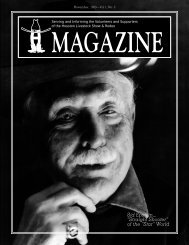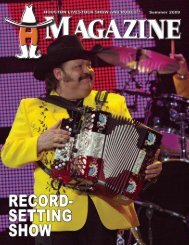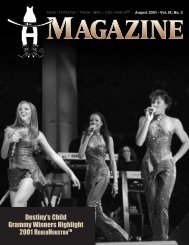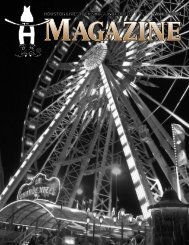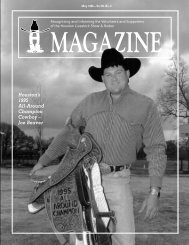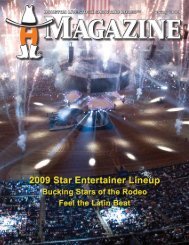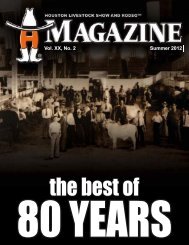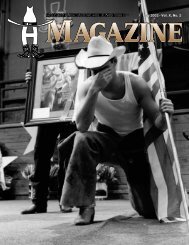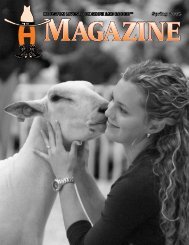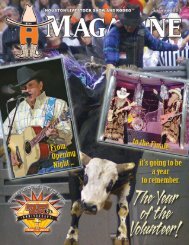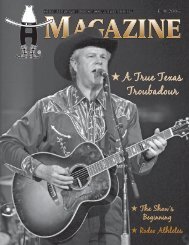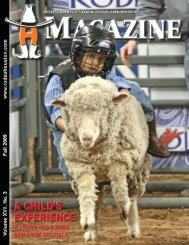Chairman of the Board - Houston Livestock Show and Rodeo
Chairman of the Board - Houston Livestock Show and Rodeo
Chairman of the Board - Houston Livestock Show and Rodeo
Create successful ePaper yourself
Turn your PDF publications into a flip-book with our unique Google optimized e-Paper software.
<strong>of</strong> space, raising one is no small task. Living quarters need<br />
daily cleaning, <strong>and</strong> fresh food <strong>and</strong> water must be <strong>of</strong>fered every<br />
day. Rabbits are very clean animals <strong>and</strong> even can be trained to<br />
use a litter box — if it is consistently kept clean. Rabbits need<br />
daily monitoring, exercise <strong>and</strong> social contact with <strong>the</strong>ir owners.<br />
For young people with limited space <strong>and</strong> funds, exhibiting<br />
rabbits <strong>of</strong>fers <strong>the</strong> opportunity to participate in competitions<br />
such as <strong>the</strong> <strong>Houston</strong> <strong>Livestock</strong> <strong>Show</strong>. A rabbit project can provide<br />
lessons in record keeping, organizational skills <strong>and</strong> <strong>the</strong><br />
spirit <strong>of</strong> competition, as well as how to be a humble winner or<br />
gracious loser.<br />
Both <strong>the</strong> ARBA <strong>and</strong> state rabbit breeders’ associations<br />
encourage <strong>the</strong> showing <strong>of</strong> both purebred <strong>and</strong> pedigreed rabbits.<br />
A casual show exhibitor or novice can have as much fun<br />
as a serious competitor. More than 25 sanctioned breeds are<br />
judged at <strong>the</strong> <strong>Houston</strong> <strong>Livestock</strong> <strong>Show</strong> every year, including<br />
<strong>the</strong> American Fuzzy Lop, Californian, Dutch, English Angora,<br />
French Lop, Himalayan, Jersey Wooly, Mini Rex, New Zeal<strong>and</strong><br />
<strong>and</strong> Satin — just to name a few. These breeds vary in body<br />
type, structure, size, color <strong>and</strong> markings. Mature adult<br />
weights span from 2 1/2 pounds to 20 pounds.<br />
Rabbits first were shown at <strong>the</strong> <strong>Houston</strong> <strong>Livestock</strong> <strong>Show</strong> in<br />
1943, when it was still known as <strong>the</strong> <strong>Houston</strong> Fat Stock <strong>Show</strong>.<br />
Only 15 breeds <strong>of</strong> rabbits were entered that year. Today, more<br />
than 30 breeds <strong>and</strong> 77 varieties are exhibited. The rabbit show<br />
at <strong>Houston</strong> is <strong>of</strong>ficially sanctioned by <strong>the</strong> ARBA <strong>and</strong> is conducted<br />
in accordance with its latest rules <strong>and</strong> breed “St<strong>and</strong>ard<br />
<strong>of</strong> Perfection” — <strong>the</strong> ARBA published manual used as <strong>the</strong><br />
guide for judging all breeds.<br />
Rabbits are judged on overall condition, color <strong>and</strong> markings,<br />
fur texture, length, density <strong>and</strong> conformation. The ARBA<br />
St<strong>and</strong>ard <strong>of</strong> Perfection lists st<strong>and</strong>ards for <strong>the</strong> 45 accepted<br />
breeds, each with a different point total distribution on different<br />
parts <strong>of</strong> <strong>the</strong> rabbit. Judges must pass rigorous tests <strong>and</strong> be<br />
familiar with each breed in order to know how to judge <strong>and</strong><br />
place each breed. Judges inform every exhibitor <strong>of</strong> <strong>the</strong> basis<br />
for <strong>the</strong> placement <strong>of</strong> his or her animal. This <strong>of</strong>fers each<br />
exhibitor an opportunity to learn from <strong>the</strong> show experience<br />
<strong>and</strong> serves to validate <strong>the</strong> judges’ decisions.<br />
There are four show categories for<br />
rabbits: <strong>the</strong> Open Breeding <strong>Show</strong>, which is for<br />
any exhibitor, whe<strong>the</strong>r pr<strong>of</strong>essional or novice,<br />
<strong>and</strong> with no minimum or maximum age<br />
restrictions; <strong>the</strong> Rabbit Youth Breeding <strong>Show</strong>;<br />
<strong>the</strong> Rabbit Meat Pen <strong>Show</strong>, for exhibitors from<br />
8 to 18 years <strong>of</strong> age; <strong>and</strong> <strong>the</strong> Rabbit Youth<br />
Judging Contest.<br />
The Rabbit Meat Pen <strong>Show</strong> focuses on <strong>the</strong> skill <strong>of</strong><br />
exhibitors to pick three rabbits at an early stage <strong>of</strong> development<br />
that display <strong>the</strong> qualities <strong>of</strong> an ideal commercial market<br />
animal for both meat <strong>and</strong> fur. This competition serves to<br />
increase <strong>the</strong> exhibitor’s knowledge <strong>of</strong> <strong>the</strong> breed <strong>and</strong> improve<br />
<strong>the</strong> quality <strong>of</strong> <strong>the</strong> herd.<br />
The Rabbit Youth Judging Contest tests youth exhibitors’<br />
rabbit knowledge <strong>and</strong> incorporates both written <strong>and</strong> h<strong>and</strong>s-on<br />
judging elements. Exhibitors compete on teams <strong>and</strong> as individuals<br />
<strong>and</strong> are broken into four age groups: First Timers, ages<br />
8 to 10; Juniors, ages 8 to 11; Intermediates, ages 12 to 14;<br />
<strong>and</strong> Seniors, ages 15 to 18. To enter this competition, a contestant<br />
must be an exhibitor in <strong>the</strong> breeding or meat pen<br />
shows. Successful exhibitors earn trophies, jackets, belt buckles<br />
<strong>and</strong> cash prizes. Awards are divided among <strong>the</strong> breeding<br />
show, meat pen show <strong>and</strong> judging contest winners.<br />
Although <strong>the</strong>re is little market dem<strong>and</strong> for rabbit meat, it<br />
still is consumed for both <strong>the</strong> taste <strong>and</strong> high nutritional value.<br />
As a meat source, rabbit meat is ranked lowest in fat, cholesterol<br />
<strong>and</strong> sodium, while boasting<br />
<strong>the</strong> highest protein value <strong>and</strong><br />
digestibility <strong>of</strong> any meat<br />
source. Rabbit pelts are<br />
used for making hats,<br />
coats <strong>and</strong> mittens.<br />
Rabbits can be<br />
bought or raised for<br />
pure pleasure or<br />
pr<strong>of</strong>it. They can<br />
become a favorite pet or<br />
raised for show. Thanks<br />
to local <strong>and</strong> nationwide support<br />
from rabbit associations,<br />
h<strong>and</strong>s-on exhibits such as <strong>the</strong> rabbit<br />
display at <strong>the</strong> <strong>Show</strong>, <strong>and</strong> dedicated<br />
rabbit fanciers, opportunities abound<br />
for <strong>the</strong> casual observer to learn <strong>the</strong>re<br />
is more to rabbits than just a cuddly,<br />
household pet.<br />
With <strong>the</strong> judge’s h<strong>and</strong> over <strong>the</strong> rabbit’s eyes<br />
so it thinks it is hidden, <strong>the</strong> rabbit can be<br />
evaluated on overall condition, color,<br />
markings <strong>and</strong> o<strong>the</strong>r characteristics.<br />
7



